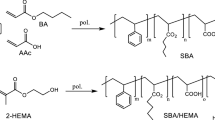Abstract
The emulsion polymerization of highly shear-stable copolymer dispersions of methyl methacrylate and butyl acrylate were carried out using poly (vinyl alcohol) with a thiol end group (PVA-SH) as protective colloid. The dispersions can be transformed into corresponding redispersible powder via a spray drying-cooling process. On-line FT-IR monitoring shows that grafting polymer of PVA-g-PMMA was formed mainly at the stage-1 of the emulsion polymerization. TEM images show, the PVA-SH shell was fragmentary when adding SDS at initial stage and integrated when adding at particle growing or final stage. The particle size turns to be smaller when delayed adding SDS surfactant. Triethanolamine, a co-regulator of PVA-SH, controlled the M n to 50 000–70 000 and reduced the PDI to 1.5–1.7. The acrylic dispersions with 0.8wt%–1.5wt% PVA-SH1 can be spray-dried into super dispersible polymer powder (SDPP), which can easily disperse in water and form reconstituted dispersions with an average particle size smaller than 1 micron.
Similar content being viewed by others
References
Guziak L F, Maclay W N. Redispersible Latex Polymer[J]. Journal of Applied Polymer Science, 1963, 7: 2249–2258
Leo M Saija, Maciej Uminski. Water-redispersible Low-Tg Acrylic Powders for the Modification of Hydraulic Binder Compositions[J]. Journal of Applied Polymer Science, 1999, 71: 1781–1787
Yoshihiko Ohama. Polymer-based Admixture[J]. Cement and Concrete Composites, 1998, 20: 189–212
Yuki K. The Role of Polyvinyl Alcohol in Emulsion Polymerization[J]. Polymer International, 1993, 30: 513–517
Hirotoshi Miyazaki, Kazutoshi Terada, Toshiaki Sato, et al. Effect of Poly(Vinyl Acetate/Vinyl Alcohol) Copolymer with a thiol End Group as a Steric Stabilizer on Dispersion Polymerization of Styrene[J]. Journal of Applied Polymer Science, 1996, 60: 2149–2157
Takuji Okaya, Atsushi Suzuki, Kenji Kikuchi. Effect of Additive on the Initial Stage of Emulsion Polymerization of Methyl Methacrylate using Polyvinyl Alcohol as a Protective Colloid[J]. Macromol. Symp., 2000 150: 143–148
Takuji Okaya, Atsushi Suzuki, Kenji Kikuchi. Importance of Grafting in the Emulsion Polymerization of MMA using PVA as a Protective Colloid: Effect of Initiators[J]. Colloids and Surfaces A: Physiochemical and Engineering Aspects, 1999,153
Author information
Authors and Affiliations
Rights and permissions
About this article
Cite this article
Lin, J., Qin, S., Lan, R. et al. Effect of polyvinyl alcohol with a thiol end group on the properties of polyacrylic dispersions and spray-dried powder. J. Wuhan Univ. Technol. 22, 261–265 (2007). https://doi.org/10.1007/s11595-005-2261-1
Received:
Accepted:
Issue Date:
DOI: https://doi.org/10.1007/s11595-005-2261-1




